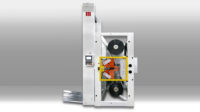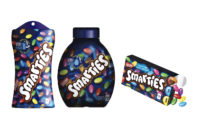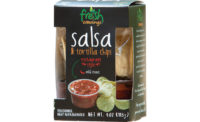We sat down and discussed Web Guiding & Tension Control with Mark Breen from Dover Flexo Electronics, Jerry Leonards from Erhardt+Leimer, Inc., and Shomari Head from Fife Guiding(Maxcess).
Have there been any recent technological advances in tension control/web guiding?
Breen: One new development is the integration of full touch-screen technology into the graphic user interfaces of tension indicators and control electronics. Touch screens provide a more intuitive user experience and replace the need for separate navigation buttons and switches on controller overlays and front panels. Dover Flexo Electronics (DFE) is migrating all of our electronics products over to the touch-screen only interfaces, such as the TriView™ Tension Indicator and the SteadyWeb6™ Tension Controller, which are recent product releases.
Leonards: We are in the age of Industry 4.0 and all the advantages that come with that. Erhardt+Leimer (EL) has released web based management (WBM) software for our web guides and tension management equipment that allows the user to connect to our devices to manage parameters, operation and firmware from any standard web browser. This could be via your phone, tablet or PC. This is the latest innovation along with direct connection to the PLC to exchange all the job and process data with the customers’ ERP and quality management systems. This technology allows the machine to be configured automatically from the ERP data. The job can run and then the machine lets the quality group know how it performed. In addition to the latest in connectivity, our drives are moving towards high speed, long life, DC brushless actuators with absolute encoders instead of the older incremental encoders. This eliminates the need for external reference switches for easier setup and more reliable operation.
Head: Digital guiding sensors are becoming increasingly important as customers want to receive the most accurate feedback data while working on ways to improve the line efficiency. Fife has moved toward providing digital options even for standard-edge sensors to accommodate customer requests. For tension, tension amplifiers and controllers are adding built-in communications like Ethernet/IP, PROFINET, Modbus TCP or EtherCAT. This allows for communication of tension data that does not rely on analog signals going to display stations like HMI’s or PLC’s for data gathering.
Secondly, some controllers allow for roll diameter inputs in addition to dancer position or load cell feedback. One feature that this diameter reference allows for gain compensation within the controller to allow stable control of the unwind or rewind rolls regardless of the size of the rolls. This allows for a very consistent control from the full roll diameter to core diameter as the size of rolls continue to grow larger to allow long processes between roll changes.
There are three tension control zones—unwind, intermediate and rewind. How do the tension controls differ in each of these areas?
Breen: Tension in the unwind zone can be controlled by a pneumatic brake, an electric brake or a regenerative drive. During machine operation the measurement signal from the tension transducers is input to an automatic tension controller. The control output signal to the unwind decreases as the roll diameter decreases in order to maintain constant tension on the material going into the next tension zone. An intermediate zone can occur prior to the main drive station, or after, or both. In this zone the transducer signal is used only to ‘trim’ the line speed signal as a follower of the main drive speed signal. This is usually at 5 to 10 percent of the maximum controller output.
When controlling a nip prior to the main drive, the tension controller output slows down the nip to create the correct tension with respect to the main drive section. If the tension-controlled nip is situated after the main drive, then the output increases the nip speed to create tension. Each section must have a positive grip on the web. Nips can be driven by clutches from a line shaft, or by a DC regenerative, AC vector or servo drive. Proper rewind tension control is essential to winding a consistent, unflawed roll and to prevent starred ends, telescoping, or offset edges of the finished wound roll. The tensioning device to be controlled is usually an electric clutch or a variable speed motor drive.
Leonards: How do the web guiding and tension controls differ in each of these areas? In web guiding you always need to place the guide as close to your critical process as you can. In large machines, the unwind and rewind can be shifted laterally to guide the material. Typically, intermediate guiding is done via a pivot frame guide or steering roller, but don’t forget other guiding technologies such as guided turn bars or segmented roll guiders. Each type of guide technology has different mechanical advantages and disadvantages and should be selected based on speed, tension, web width, entry/exit span as well as accuracy required. On the tension side, one must weigh the advantages and cost requirements of each tension control method. Dancers still have their place, even though they are often misunderstood. Open-loop control can be a cost savings but if your material is sensitive to tension fluctuations, it might not be your best option. Conversely, closed loop offers the most control but at a higher price tag.
Head: In a lot of cases for tension control, the same controllers can be used in all of these zones but would be set up differently. In some cases there are different controllers or a differ style of controller that you may want to used based on which zone you are controlling. In general, the goal when controlling tension on an unwind is to make sure that the tension is kept constant. A web needs constant tension going into a process line to be processed efficiently. When controlling the rewind tension, you may want to control with constant tension, but in many cases “taper tension” may be required. This turns down the tension by a certain percentage to rewind a roll “package” that ensures the material is wound without damaging itself. Taper tension also can stop dishing, telescoping, crushed cores and starring. In intermediate zones, control of tension can sometimes be controlled using manual controllers as we generally are controlling nips, vacuum rollers or S wraps where the diameter is not changing as it does on rewinds and unwinds.
When purchasing tension control equipment, what major factors should be considered?
Leonards: Application and flexibility of the equipment are very important. At EL we have very simple-to-setup systems that cover the majority of the applications. Over the years simplicity has been a major driver for product development. Just because it can be simpler to operate doesn’t mean that all the features and options aren’t still there. One tension controller, the DC62, works in unwind /transport/rewind, open loop, dancer, closed loop and even has a built-in power stage for direct connection to 24V magnetic particle brakes. This same platform has an easy to use LCD touchscreen with a setup wizard to make commissioning extremely easy. It is also out-of-the-box ready to connect to an Allen Bradley PLC via Ethernet IP. This unit is also very cost competitive. One of the most frequent questions I receive is always: “Should I replace my dancer on my unwind?” It depends on application and the condition of your roll, but in my experience a dancer with closed loop position control is still the best option in case of poor incoming rolls. If you were to replace the dancer with load cell control and you have poorly wound or egg shaped rol, the load cells will never keep up with the velocity changes of the material resulting in extremely poor tension control. Keep the dancer!
Head: There are several factors to consider. Is the process continuous or does it start and stop? What are the minimum and maximum line speeds? Are the unwind rolls round and in good shape or are they out-of-round and lumpy? What is the roll build ratio? (full roll diameter to core diameter ratio) All of these questions will be important when deciding to use a dancer or load cells and additional signals desired to design the correct control system for your process. Lastly, do you want a stand-alone controller that is your operator’s main input for tension set point or should it be integrated into your machine network.
Breen: Assuming that management will choose a tension control technology that employs direct tension sensing to achieve the most consistent and accurate running tensions, other key considerations for correcting tension-related web quality problems on a machine are:
- In which tension zones are problems being experienced? Unwind, Intermediate, or Rewind?
- What idler roll locations in the web path are best suited to have tension transducers (load cells) installed on them?
- What are the project budget constraints?
- What tension range will be running in most of the time? This is important for transducer sizing.
- How versatile do you need the tension control system to be with respect to the range of substrates and material properties the machine will be running?
- Which tension measurement and control vendor will best fill your needs?
- What style of transducer mounting hardware will fit best into this location on the machine frame?
- Should you connect the installed tension transducers to a tension readout device only, or to a closed-loop automatic tension controller?
Ultimately, the production team will want to select tension transducers within their budget that will be accurate over the range of tensions the machine will be running. Fortunately, some suppliers offer a range of controllers with varying feature sets and price points to meet customer needs.
Converters use a wide variety of films in different thicknesses. How does this affect the tension control process?
Head: The varying widths and thicknesses affect the tension control in two basic ways. The first is to calculate what is the smallest value of tension and what is the largest value of tension that needs to be run on the machine due to the various widths and thicknesses. This allows for the proper sizing of load cells, dancers and the torque devices used to apply that tension. Second, these variations, if extreme enough, can drive the need for different PID loop tuning values. They may drive the need for a different recipe depending on the material being run which can normally be stored in the controller or changed with the communications if connected.
Breen: For converters who are running a wide range of film thicknesses on their machines and presses, they will need to choose tension transducers (load cells) with a load rating that can accommodate the entire range of tensions. Fortunately, tension control equipment manufacturers make transducers that can cover a wide operating range, from 10 lbs up to 200 lbs. In a situation where a single line is running a highly diverse range of substrate thicknesses, or when there are differences in film extensibility that require tensions from a few grams up to hundreds of pounds, the converter would need to add ultra-low tension-sensing devices in the web path. This case would warrant the use of the dual calibration feature in the electronics devices connected to the transducers as well.
Leonards: With the thicker films it is possible to guess and pull as hard as you can and the material can be very forgiving. As the films have gotten thinner, the process control window has gotten tighter for tension control. It becomes much easier to induce wrinkles, neck down the material in width or even break the web. All of these errors can be costly due to poor quality material delivered to the end user or expensive overruns/machine downtime. Using appropriate tension control zones with sensitive load cells can help mitigate these costly errors. It is possible to monitor for neck down with width measurement that can be built into or separate from EL guiders. This can give the operator direct feedback if they are causing errors from running too high of a tension set point. Sometimes thinner materials can start to act more like a fine textile that needs to be spread back to a fixed width before the rewind. EL has a segmented roll product line that incorporates a driven guide roll as well as spreading to width. The drive is controlled with direct feedback from the load cells. This gives instant feedback on both width and tension and has been applied in many industries from textile, rubber and also film.
Are advanced machine communication processes improving web controls? If so, how?
Leonards: Absolutely! From being on the leading edge of Industry 4.0 with our digital platform, it is possible to both monitor and control the guiders and tension control products from both traditional PLCs and standard web browsers. This allows for advanced troubleshooting as well as data exchange between the customer ERP system for machine setup and the quality control department for both preventative maintenance and also failure analysis. By mining all this data, it is possible to ensure higher quality products get to the end customer all while reducing unplanned machine downtime and when there is unplanned downtime it is easy to remotely troubleshoot what the root cause of the problem is.
Head: Our customers are asking for more networking options to better integrate our controls into their machine with networking and/or common HMI screens. Controllers that can be mounted on the machine or in electronic panels with built in communications like Ethenet/IP, PROFINET, Modbus TCP or EtherCAT are good examples. We have included these in our latest Fife D-MAX Enhanced Controller and MAGPOWR DLCA-NET Tension Amplifier. These features help allow machine manufactures to better integrate these external controllers into their machines while including things like recipe setups to eliminate setup time.
I do not think that communications are making tension controls better. The communications are certainly making the transfer of data from the web easier to access and store. Some of the data tools available include time stamping which allows process analysis throughout the machine with synchronized time data. The communications are becoming a preferred method of data collection and also allows for redundancy connections with features like DLR rings in daisy chained connected devices. So where it may not help web controls, it helps customers improve their process control.
Breen: Yes, advanced machine communication processes and connectivity to a centralized control network are forcing tension controls manufacturers to incorporate the same connectivity features that all auxiliary components will be expected to include now and in the future. At DFE, we’re all assessing which connectivity protocols to pursue with Ethernet/IP, Profinet, and Modbus TCP/IP offering adoption advantages.
Anything you’d like to add about web guiding and tension controls?
Head: Effective web guiding and tension control are vital to flexible packaging to reduce scrap and prevent issues caused by neck-down, wrinkling, and baggy webs. Be sure to choose a web guiding system that not only performs well, but also responds rapidly to large incoming position errors and provides all of the performance data you require to help maximize efficiency throughout your processes. In addition, for a web guide to work properly, you must have decent tension control. So, these two web controlling devices to go hand in hand.
Breen: We see the future of the stand-alone, fully-enclosed, full-featured tension controller that we have been innovating for the past 40 years giving way quickly to network-connected smart tension transducers and amplifiers with advanced self-diagnostic capabilities. These smarter tension-sensing devices will connect to idler rollers in the web path the same way they do today, but their built in fault detection and self-diagnostic capabilities will reduce machine maintenance costs and allow increased machine uptime.
Leonards: Everything seems to be getting faster, wider and with tighter tolerances. The advances of the industrial internet of things (Industry 4.0), as well as the new technology for faster control with DC brushless actuators, puts EL at the front of the technology curve to meet the most demanding applications with our 100 years of experience.










